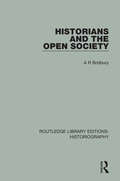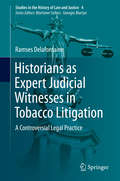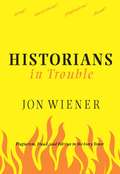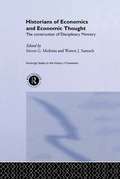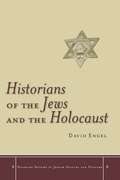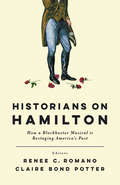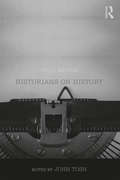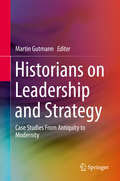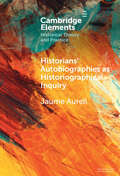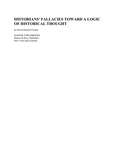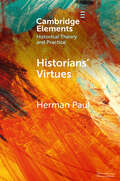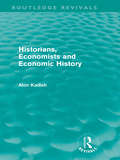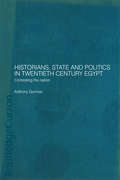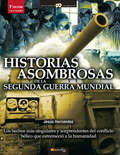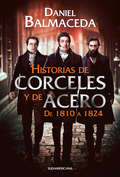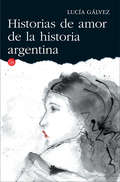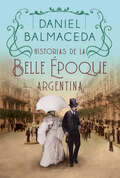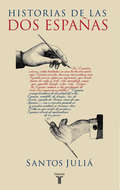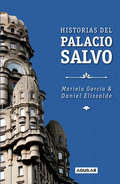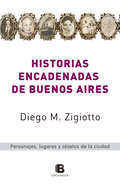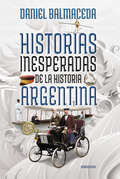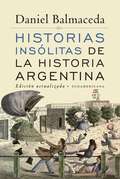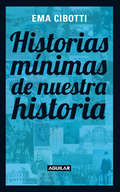- Table View
- List View
Historians and the Open Society (Routledge Library Editions: Historiography #7)
by A. R. BridburyIn this volume, originally published in 1972, the author discusses the conflict between the historian’s own expressed political views and the judgements he makes on political events in history.
Historians as Expert Judicial Witnesses in Tobacco Litigation
by Ramses DelafontaineHistorian Ramses Delafontaine presents an engaging examination of a controversial legal practice: the historian as an expert judicial witness. This book focuses on tobacco litigation in the U. S. wherein 50 historians have witnessed in 314 court cases from 1986 to 2014. The author examines the use of historical arguments in court and investigates how a legal context influences historical narratives and discourse in forensic history. Delafontaine asserts that the courtroom is a performative and fact-making theatre. Nonetheless, he argues that the civic responsibility of the historian should not end at the threshold of the courtroom where history and truth hang in the balance. The book is divided into three parts featuring an impressive range of European and American case studies. The first part provides a theoretical framework on the issues which arise when history and law interact. The second part gives a comparative overview of European and American examples of forensic history. This part also reviews U. S. legal rules and case law on expert evidence, as well as extralegal challenges historians face as experts. The third part covers a series of tobacco-related trials. With remunerations as high as hundreds of thousands of dollars and no peer-reviewed publications or communication on the part of the historians hired by the tobacco companies the question arises whether some historians are willing to trade their reputation and that of their university for the benefit of an interested party. The book further provides 50 expert profiles of the historians active in tobacco litigation, lists detailing the manner of the expert's involvement, and West Law references to these cases. This book offers profound and thought-provoking insights on the post-war forensification of history from an interdisciplinary perspective. In this way, Delafontaine makes a stirring call for debate on the contemporary engagement of historians as expert judicial witnesses in U. S. tobacco litigation.
Historians in Trouble
by Jon WienerHistorians in Trouble is investigative journalist and historian Jon Wiener's "incisive and entertaining" (New Statesman, UK) account of several of the most notorious history scandals of the last few years.Focusing on a dozen key controversies ranging across the political spectrum and representing a wide array of charges, Wiener seeks to understand why some cases make the headlines and end careers, while others do not. He looks at the well publicized cases of Michael Bellesiles, the historian of gun culture accused of research fraud; accused plagiarists and "celebrity historians" Stephen Ambrose and Doris Kearns Goodwin; Pulitzer Prize-winner Joseph J. Ellis, who lied in his classroom at Mount Holyoke about having fought in Vietnam; and the allegations of misconduct by Harvard's Stephan Thernstrom and Emory's Elizabeth Fox-Genovese, who nevertheless were appointed by George W. Bush to the National Council on the Humanities.As the Bancroft Prize-winning historian Linda Gordon wrote in Dissent, Wiener's "very readable book . . . reveal[s] not only scholarly misdeeds but also recent increases in threats to free debate and intellectual integrity."
Historians of Economics and Economic Thought: The Construction Of Disciplinary Memory (Routledge Studies In The History Of Economics Ser.)
by Steven G. Medema Warren J. SamuelsThe history of economic thought has always attracted some of the brightest minds in the discipline. These chroniclers of development have helped form our current views, and it is no surprise that many among them have been at the forefront of new movements in the history of ideas.This notable collection summarizes the work of these key historians of
Historians of the Jews and the Holocaust (Stanford Studies in Jewish History and Culture)
by David EngelThe Nazi Holocaust is often said to dominate the study of modern Jewish history. Engel demonstrates that, to the contrary, historians of the Jews have often insisted that the Holocaust be sequestered from their field, assigning it instead to historians of Europe, Germany, or the Third Reich. He shows that reasons for this counterintuitive situation lie in the evolution of the Jewish historical profession since the 1920s. This one-of-a-kind study takes readers on a tour of twentieth-century scholars of the history of European Jewry, and the social and political contexts in which they worked, in order to understand why many have declined to view their subject from the vantage point of Jews' encounter with the Third Reich. Engel argues vehemently against this separation and describes ways in which a few exceptional scholars have used the Holocaust to illuminate key problems in the Jewish past.
Historians on Hamilton: How a Blockbuster Musical Is Restaging America's Past
by William Hogeland Elizabeth L. Wollman Jeffrey L. Pasley Michael O'Malley Jim Cullen David Waldstreicher Catherine Allgor Renee C. Romano Andrew M. Schocket Brian Eugenio Herrera Joanne B. Freeman Claire Bond Potter Lyra D. Monteiro Leslie M. Harris Joseph M. Adelman Patricia HerreraAmerica has gone Hamilton crazy. Lin-Manuel Miranda’s Tony-winning musical has spawned sold-out performances, a triple platinum cast album, and a score so catchy that it is being used to teach U.S. history in classrooms across the country. But just how historically accurate is Hamilton? And how is the show itself making history?Historians on Hamilton brings together a collection of top scholars to explain the Hamilton phenomenon and explore what it might mean for our understanding of America’s history. The contributors examine what the musical got right, what it got wrong, and why it matters. Does Hamilton’s hip-hop take on the Founding Fathers misrepresent our nation’s past, or does it offer a bold positive vision for our nation’s future? Can a musical so unabashedly contemporary and deliberately anachronistic still communicate historical truths about American culture and politics? And is Hamilton as revolutionary as its creators and many commentators claim? Perfect for students, teachers, theatre fans, hip-hop heads, and history buffs alike, these short and lively essays examine why Hamilton became an Obama-era sensation and consider its continued relevance in the age of Trump. Whether you are a fan or a skeptic, you will come away from this collection with a new appreciation for the meaning and importance of the Hamilton phenomenon.
Historians on History
by John ToshBringing together in one volume the key writings of many of the major historians from the last few decades, Historians on History provides an overview of the evolving nature of historical enquiry, illuminating the political, social and personal assumptions that have governed and sustained historical theory and practice. John Tosh’s Reader begins with a substantial introductory survey charting the course of historiographical developments since the second half of the nineteenth century. He explores both the academic mainstream and more radical voices within the discipline. The text is composed of readings by historians such as Braudel, Carr, Elton, Guha, Hobsbawm, Scott and Jordanova. This third edition has been brought up to date by taking the 1960s as its starting point. It now includes more recent topics like public history, microhistory and global history, in addition to established fields like Marxist history, gender history and postcolonialism. Historians on History is essential reading for all students of historiography and historical theory.
Historians on Leadership and Strategy: Case Studies From Antiquity to Modernity
by Martin GutmannThis book examines the well-covered subject of leadership from a unique perspective: history's vast catalogue of leadership successes and failures. Through a collection of highly compelling case studies spanning two millennia, it looks beyond the classic leadership parable of men in military or political crises and shows that successful leadership cannot be reduced to simplistic formulae.Written by experts in the field and based on rigorous research, each case provides a rich and compelling account that is accessible to a wide audience, from students to managers. Rather than serving as a vehicle for advancing a particular theory of leadership, each case invites readers to reflect, debate and extract their own insights.
Historians' Autobiographies as Historiographical Inquiry: A Global Perspective (Elements in Historical Theory and Practice)
by Jaume AurellThis Element analyses the autobiographies of historians from a global perspective and looks at all eras, from antiquity to the present day. It includes twenty autobiographies: Caesar's and Lucian of Samosata's memories in antiquity; an autobiography of a medieval king such as Peter IV of Aragon; Vico's, Gibbon's and Adams' intellectual self-accounting in modernity; autobiographical revelations and social activism of twentieth century women historians such as Carolyn Steedman, Jill Conway and Gerda Lerner; classical Chinese and Islamic traditions through the autobiographies of Sima Quian and Ibn Khaldun; the perplexities inherent in the modernisation of Japan (Fukuzawa Yukichi), China (Gu Jiegang), India (Nirad Chaudhuri) and Egypt (Taha Hussein); postmodernists such as Rosenstone; and traumatic postcolonial experiences in Africa (Bethwell Ogot), Latin America (Carlos Eire) and Southeast Asia (Wang Gungwu). This Element proposes a literary and historical approach to these autobiographies, emphasising its historiographical dimension and value.
Historians' Fallacie: Toward a Logic of Historical Thought
by David Hackett Fischer"If one laughs when David Hackett Fischer sits down to play, one will stay to cheer. His book must be read three times: the first in anger, the second in laughter, the third in respect....The wisdom is expressed with a certain ruthlessness. Scarcely a major historian escapes unscathed. Ten thousand members of the American Historical Association will rush to the index and breathe a little easier to find their names absent.
Historians' Virtues: From Antiquity to the Twenty-First Century (Elements in Historical Theory and Practice)
by Herman PaulWhy do historians so often talk about objectivity, empathy, and fair-mindedness? What roles do such personal qualities play in historical studies? And why does it make sense to call them virtues rather than skills or habits? Historians' Virtues is the first publication to explore these questions in some depth. With case studies from across the centuries, the Element identifies major discontinuities in how and why historians talked about the marks of a good scholar. At the same time, it draws attention to long-term legacies that last until today. Virtues were, and are, invoked in debates over the historian's task. They reveal how historians position themselves vis-à-vis political regimes, religious traditions, or neoliberal university systems. More importantly, they show that historical study not only requires knowledge and technical skills, but also makes demands on the character of its practitioners. This title is also available as Open Access on Cambridge Core.
Historians, Economists, and Economic History (Routledge Revivals)
by Alon KadishFirst published in 1989, Alon Kadish’s study re-examines the standard view held by historians of economic thought whereby economic history emerged from the historicist criticism of neoclassical economic theory. He also demonstrates how the discipline evolved as an extension of the study of history. The study will appeal to students and scholars in historiography, the development of higher education and in the history if economic thought in general, as well as all those interested in the evolution of Oxford and Cambridge.
Historians, State and Politics in Twentieth Century Egypt: Contesting the Nation (Routledge Islamic Studies Series)
by Anthony GormanThis book deals with the relationship between historical scholarship and politics in twentieth century Egypt. It examines the changing roles of the academic historian, the university system, the state and non-academic scholarship and the tension between them in contesting the modern history of Egypt. In a detailed discussion of the literature, the study analyzes the political nature of competing interpretations and uses the examples of Copts and resident foreigners to demonstrate the dissonant challenges to the national discourse that testify to its limitations, deficiencies and silences.
Historias asombrosas de la Segunda Guerra Mundial (Historia Incógnita)
by Jesús Hernández MartínezUna ingeniosa recopilación de hechos y episodios históricos poco conocidos, que marcaron el día a día de este convulso periodo histórico, pero que han quedado fuera de los grandes libros de historia
Historias de Corceles y de Acero
by Daniel BalmacedaCuando evocamos los años de la Revolución de Mayo recurrimos a la iconografía que conocimos en el colegio. Nos situamos en la plaza histórica en medio de la lluvia o en el Cabildo Abierto, donde cada orador exponía sus ideas. Detrás de esas imágenes tan familiares existen centenares de sucesos escondidos que nos permiten reflexionar con mayor profundidad y en una dimensión más completa, sobre el peso de nuestro pasado. Anécdotas que no necesitan ser solemnes para ser importantes y que, justamente, por algo no aparecieron representadas en las figuritas que nos mostraban cómo habían sido los hechos. Daniel Balmaceda ha comprobado en todos sus libros que se puede observar la historia desde otro lugar, con otros puntos de vista, sin perder rigor y ganando interés. En Historias de corceles y de acero atravesamos junto a Moreno, en una noche solitaria, la recova que estaba en medio de la plaza; y nos enteramos desde cuánto ganaban y dónde vivían nuestros próceres, o quién terminó usando el sable que empleó San Martín en San Lorenzo, hasta cómo fue la guerra de peinados floggers entre las jovencitas de 1817. Como dice el autor, la historia de la Patria es mucho más humana de lo que solemos imaginarla.
Historias de amor de la historia argentina
by Lucía GálvezUn libro para mirar nuestro pasado con nuevos ojos. Muchas de estas historias fueron transmitidas a través del tiempo en relatos susurrados, a escondidas, en reuniones, corrillos y tertulias. Porque la mujer, el sexo y el amor son parte elemental de la historia, pero las convenciones sociales los ocultaron de la publicidad y la historiografía no siempre les otorga la importancia debida. Con relatos sencillos basados en investigaciones rigurosas, Lucía Gálvez contribuye a llenar ese vacío narrándonos historias de amores fundacionales del pasado, desde las que protagonizaron las concubinas indias y las esposas españolas de la conquista y el poblamiento hasta los amores secretos de Rodríguez Peña e Yrigoyen.
Historias de corceles y de acero (de 1810 a 1824)
by Daniel Balmaceda¿Cómo era la Argentina entre 1810 y 1824? Hay un montón de sucesos ocultos en los años posteriores a la Revolución de Mayo. Hechos inéditos que no aparecen en los libros tradicionales de historia. Daniel Balmaceda observa la historia desde otro lugar, con otros puntos de vista, fomentando el interés sin perder rigor. En este libro nos invita a atravesar, junto a Moreno, la recova de la plaza en una noche solitaria; y a enterarnos de cuánto ganaban y dónde vivían nuestros próceres; quién terminó usando el sable que empleó San Martín en San Lorenzo, o cómo fue la guerra de peinados entre las jovencitas de 1817.
Historias de la Belle Époque argentina
by Daniel BalmacedaUna invitación a recorrer los espléndidos años dorados de la Belle Époque argentina. De las últimas décadas del siglo XIX al Centenario de la Revolución de Mayo, en 1910, y los años previos a la Primera Guerra Mundial. Este libro es una invitación a recorrer los espléndidos años dorados de la Belle Époque argentina. De las últimas décadas del siglo XIX al Centenario de la Revolución de Mayo, en 1910, y los años previos a la Primera Guerra Mundial. Una época de gran prosperidad, cuando el porvenir era esperanza y desarrollo. Tiempos de inmigración masiva; de inicio del ocio, de la gastronomía, del transporte y de mujeres que, por primera vez, se animaban a reclamar sus derechos. Espiamos el diario de Delfina Bunge y sus observaciones de quienes iban a misa, asistimos a un baile de fin de año, presenciamos el primer llamado telefónico, la aparición de los autos eléctricos, el miedo frente al primer vuelo en avión y el caso cero de una temible vuelta de la fiebre amarilla. ¿Cómo eran los dandis por esos días? ¿Cuántos años tenía el niño que quiso matar a Roca? ¿Cómo desbarató José Hernández una edición trucha del Martín Fierro? Decenas de casos de emprendedores que armaron un imperio con una máquina rudimentaria en un sótano: de Fort a Rigolleau. Historias nacidas de la incansable búsqueda que Daniel Balmaceda realiza desde hace años en periódicos, revistas y documentos inéditos de todo tipo, para descubrir y rearmar las piezas perdidas de nuestra historia.
Historias de las dos Españas
by Santos JuliáUna historia coral de las sucesivas, contradictorias y enfrentadas historias de las dos Españas. «Dos Españas, señores, están trabadas en una lucha incesante», dijo en cierta ocasión Ortega, resumiendo con su proverbial aplomo una historia de siglos. Dos Españas que son, más que el resultado de un análisis, el gran relato de un pasado con el propósito de abrir un futuro: «una España muerta, hueca y carcomida y una España nueva, afanosa, aspirante, que tiende hacia la vida». De esa creación cultural y de los sujetos que la inventaron y la echaron a rodar trata este magistral libro de Santos Juliá, en un recorrido que abarca desde los primeros escritores públicos, testigos de la revolución liberal de principios del siglo XIX, a los jóvenes intelectuales de mediados del siglo XX, protagonistas de la recusación del gran relato de las dos Españas. Entre medias, la generación del 98, que dio a España por muerta; los catalanes, que despertaron a su nación para incrustarla en una Espanya gran; las gentes del 14, que hablaron de una España viva; los jóvenes de la República, que acabaron llorando su pérdida; los católicos, que salieron a su reconquista; y los fascistas, que la soñaron, unida e imperial, a orillas del Arlanzón. ** Obra galardonada con el Premio Nacional de Historia de España 2005.
Historias del Palacio Salvo
by Daniel Elissalde Mariela GarcíaEn este libro, a través de sus investigaciones y de su pasión, los autores nos invitan a recorrerlo para descubrir su historia y las historias que, en sus entrañas, se tejieron a lo largo del tiempo. El Palacio Salvo es una silueta que identifica a Montevideo, un símbolo de hormigón y hueso. Es Historia y presente. En él hay memorias y misterios, pasillos silenciados, pinturas escondidas en sus entrepisos, acordes de La cumparsita, ecos de grandes bailes en sus soberbios salones, historias latentes en sus recovecos, arquitectura simbólica, arte y, también, vida cotidiana de los habitantes pasados y presentes. Lo vemos a diario, pero no hay mirada que pueda abarcar todo lo que muestra o sugiere.
Historias encadenadas de Buenos Aires
by Diego M. ZigiottoUn relato se construye a partir de una combinación particular de elementos que producen un sentido. En Historias encadenadas de Buenos Aires, Diego M. Zigiotto pone en relación objetos, lugares y personajes que aparecen y reaparecen a lo largo de los años en la ciudad. Como los eslabones de una cadena, esta sucesión de anécdotas, leyendas y datos diseña diferentes recorridos que permiten trazar un original mapa de Buenos Aires y de su historia como un juego en el que cada lector elige su propio camino. Un paraguas que usa Adolfo Alsina para defenderse de algunos manifestantes, otro que abre José Ignacio Rucci para cubrir a Juan Domingo Perón de la lluvia. El apodo que Rucci adquirió a partir de su muerte, “Traviata”, las galletitas y la ópera de Giuseppe Verdi con la que se inauguró el viejo Teatro Colón. Cómo nació el tango "Cuartito azul”, en donde se conocieron Aristóteles Onassis y Carlos Gardel, qué historia se esconde detrás de la magnolia del parque Tres de Febrero o del ombú que aún se alza en la esquina de Pizzurno y Paraguay. Hormigas que mira Angel Gallardo, hormigas que descubren un tesoro. Tesoros que buscaban los adelantados y calabazas que sirven para dar aviso de que hay que huir. Las historias de Buenos Aires son innumerables, pero solo alguien que las conoce a fondo puede armar un entramado que permite al lector ir y venir por los porteños senderos que se bifurcan. Si bien cada una de las historias que componen este libro puede leerse de manera independiente, Historias encadenadas de Buenos Aires propone un viaje asombroso que enlaza historias mínimas, casuales, cotidianas y no tanto, objetos, lugares y personajes conocidos o anónimos, que conforman las piezas de este rompecabezas mítico e inevitable llamado Buenos Aires.
Historias inesperadas de la historia argentina: Tragedias, misterios y delirios de nuestro pasado
by Daniel BalmacedaLa historia argentina está repleta de personajes y situaciones increíbles, y quién mejor que Daniel Balmaceda para descubrir y contarnos con su prosa rigurosa y cálida estas historias insólitas. San Martín es dado por muerto cuatro años antes de fallecer. Avellaneda sale al balcón de la Casa Rosada para enfrentar a una multitud y lo ovacionan como si fuera Perón. Luis Viale escribe su página gloriosa en uno de los naufragios más absurdos. La madre de un presidente le impone una novia que él no quiere. Un ministro parece haber muerto en circunstancias muy comprometedoras, y un empresario cambió su testamento cuando ya estaba muerto. Como dice el mismo autor: «Muchos relatos de las "Historias inesperadas" parecen más adecuados al mundo de la ficción. Sin embargo, cada uno de ellos ha ocurrido y cualquier similitud con la historia real no es ninguna casualidad».
Historias insólitas de la historia argentina (Edición Actualizada)
by Daniel BalmacedaLa edición definitiva del libro más divertido que se haya publicadosobre historia argentina de los siglos XIX y XX. Daniel Balmaceda logra transmitir entusiasmo por la historia. Losveintitrés hijos de Urquiza; por qué la ex confitería Del Molino sellama así y qué tiene que ver con un francés que viajaba en globo; laprimera gobernadora de facto; corridas de toros en la 9 de Julio; lamaestra que inventó el guardapolvos blanco; cuando el zoológico era unapensión para Onelli y se fue a vivir allí; cuando Quinquela Martín niñopintaba con el carbón que vendía su padre adoptivo; el día que elpresidente Julio A. Roca fue guardavidas; quién fue el Rin Tin Tin denuestras pampas; la negra María Haedo de Acosta que murió a los 127años, son solo algunas de las anécdotas que recopila esta edición.
Historias mínimas de nuestra historia
by Ema CibottiLa historiadora Ema Cibotti rescata del olvido pequeñas historias que revelan una espesa trama de hechos menudos, muchas veces obviados que sin embargo son constitutivos de nuestro pasado. Nuestra nación puede compararse con un edificio en perpetua construcción. A lo largo de la historia se han ido levantando los cimientos, las columnas y las vigas, y su fachada suele variar de color según quién se haga cargo del relato. Pero para descubrir los ladrillos y el cemento que le dan significado y lo hacen habitable, esos relatos no son suficientes: es necesario acercarse, palpar los ladrillos y hurgar debajo de las muchas capas de pintura que los cubren. La historiadora Ema Cibotti agregó a sus conocimientos la búsqueda en cartas y memorias, en documentos oficiales y particulares, y con eso urdió estas pequeñas historias que revelan una espesa trama de hechos menudos, muchas veces obviados o directamente a punto de perderse en el olvido, que sin embargo son constitutivos de nuestro pasado, como lo son de ese edificio los ladrillos y el cemento. Los redactores de la Constitución en una tórrida aldea llamada Santa Fe; la declaración de amor de Carmen, la esposa del cacique Railef; más de sesenta ediciones de Anagnosia, el libro para aprender a leer que se vendía en el almacén; la verdadera revolución que avanzaba detrás de una zanja casi interminable; 459 diarios sostenidos por el ansia de información; tres seudónimos para una original operación literaria; la excluida población negra; mujeres maestras, mujeres periodistas, mujeres poetas, mujeres bandoneonistas; los protagonistas de un cuadro trágico; puchero, pizza y milanesas; un dandy en las filas de la democracia, son algunas de las historias que componen esta obra y que consolidan el edificio que seguimos construyendo. La crítica ha dicho... «La historiadora Ema Cibotti, sin demagogias discursivas ni afán de derribar próceres para ganarse a los detractores del sistema escolar, renueva la visión de la historia alumbrando rincones deliciosos y polémicos del escenario nacional.» Silvia Hopenhayn, La Nación
